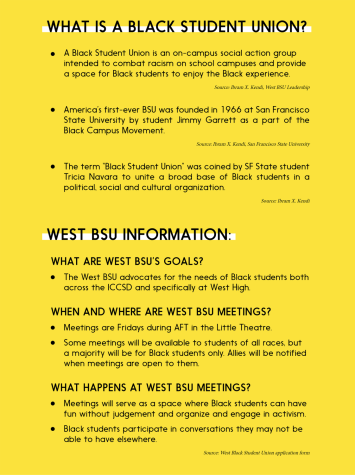Your donation will support the student journalists of West High School. Your contribution will allow us to purchase Scholarship Yearbooks, newsroom equipment and cover our annual website hosting costs.
What is the BSU?
January 20, 2022
The first BSU was founded in 1966 at San Francisco State University as a part of the Black Campus Movement aiming to reform higher education. Eventually, their mission shifted towards a common goal for all Black Student Unions: to unify and empower Black students in the struggle for equality. Elgaali believes that even though progress towards equality has been made, a BSU continues to be crucial today in fighting back as people become confident in their ignorance.

“Just because Jim Crow is not a thing anymore, just because the things that used to be in our faces aren’t in our faces anymore and it’s just hidden systemically, doesn’t mean that things got all the way better,” Elgaali said.
West High had a BSU last year, which held meetings online due to COVID-19. Former social studies teacher Amira Nash was the adviser. However, once Nash left for a job at the University of Iowa, the BSU disbanded. Now, the newly reestablished BSU operates differently than last year’s — meetings are in person and student-led.
“I think it was a student effort,” said Assistant Principal Maureen Head. “They just told us, ‘This is something that we need to feel supported, and this is something that we need as Black students at West.’”
Part of the BSU’s purpose is to create a support system for Black students in the form of meetings where they can be around each other and feel like themselves. This is why some meetings are for Black students only while some welcome allies.
The first BSU meeting occurred during AFT in the Little Theatre Nov. 19. After the meeting, some BSU members participated in a district-wide walkout to the Pentacrest, marching and chanting with posters to raise awareness about racism in the district. Prior to the walkout, West administration sent an email to staff and parents expressing their support of students’ right to protest and use their voices.
The BSU’s next meeting was dedicated to mental health. The meeting was for Black students only where they watched Netflix, had snacks, made bracelets and played card games. There was also a restorative justice circle for anyone who wanted to talk about the events happening at school and to have a support system in processing them. Kazembe feels this meeting created a necessary place for students to just be kids.
“It’s sad they have to look for places to just be themselves, but I’m happy that I can see people who I have never seen smile before, smile … I can see people that I’ve never seen genuinely laugh, laugh,” Kazembe said. “I’m just so happy that they have a place to be their true, authentic selves.”
The BSU is meant to be a safe space for Black students of all different identities and embraces that being Black does not have a definite “look.”
“The BSU is for everybody who supports Black students, [and] not only just Black students, but queer Black students, Muslim Black students, Asian Black students,” Elgaali said. “There’s so many intersectionalities that go into [being Black].”
Along with providing a sense of community, the BSU is advocating for Black students within the district. Through the formative process, the BSU continues to meet with administration as well as attend school board meetings. Often, board members or workers in the district will ask the leaders for clear examples of things students have experienced to gauge the problems and better formulate solutions. To do this, the leaders share students’ testimonies with permission.
Kariuki wants people to know the BSU strives to make a difference and acknowledges part of that may have to be through making some noise.
“We’re here to peacefully make a difference,” Kariuki said. “We’ve never ever tried to do anything violent, and we’ve never purposely tried to upset anybody, but we also know that upsetting people is the way that we’re gonna get change.”
Part of the BSU’s advocacy for change is done through protests such as the walkout. It saddens Kariuki to hear about peers who feel the protests are only a disturbance.
“I feel like the reason why they also feel [protests are disruptive] is just because the school has done such a poor job of being transparent with the problems within West,” Kariuki said. “I wouldn’t necessarily just blame them, but also encourage them to try and understand why we’ve done stuff like that.”
Elgaali agrees that administration has not been transparent. However, she believes there has been improvement since the BSU began meeting with administrators.
Through protests and meetings, the BSU leaders hope to raise awareness for racial injustices students are not aware of.
“A big thing is awareness, because I know I’ve heard so many [white] people say ‘That doesn’t actually happen,’ so it’s like, ‘Yeah, it doesn’t happen to you,’” Ochola said. “Some people are still just going to want to live in ignorance to ignore the fact that they are the problem.”
